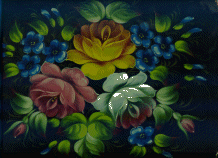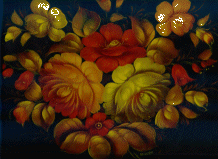



In the art of Zhostovo lives a rich hereditary native culture. The art of Zhostovo began in the early 19th century, when craftsmen began making various items of lacquered paper mache. They opened their first workshop in 1825, producing: boxes, cases, snuff boxes and other articles. The original trays featured troika driving, genre scenes, landscape and floral ornamentation.
Later the craftsmen turned their attention to making the trays of metal. They painted realistic garden and field flowers in bouquets and garlands. However, the practice of painting bunches of flowers became the most popular. The fascination of the art of Zhostovo lies in itís honesty and the directness of itís artistic content. To understand and appreciate the art, you donít need any special knowledge. The themes of the artist rouse the feeling of beauty in everyone looking at them. The art of Zhostovo blends folk art with realistic floral painting.
The unique and beautiful painting style which emerged at the beginning of the nineteen century, has been successfully developed in our own day. Under the brushes of skilled craftsmen the true-to life subject attains the highest quality of artistic production. The best traditions of this popular folk art are preserved by the modern artists of Zhostovo, who manage to unite the traditional methods with the improvisation and individual talent of each master.
In the art of Zhostovo there is no repitition, every tray has a unique variation of the flower theme in itís picturesque, still life composition Through the creativeness and successes of the artists, Zhostovo today demonstrates it's contemporariness. Under the brush of skilled craftsmen these domestic utensils are suitable to decorate any home.
Today the art of the Zhostovo can be seen in homes and museums throughout the world.





This Page Hosted by
![]() Get Your Own
Free Home Page
Get Your Own
Free Home Page





